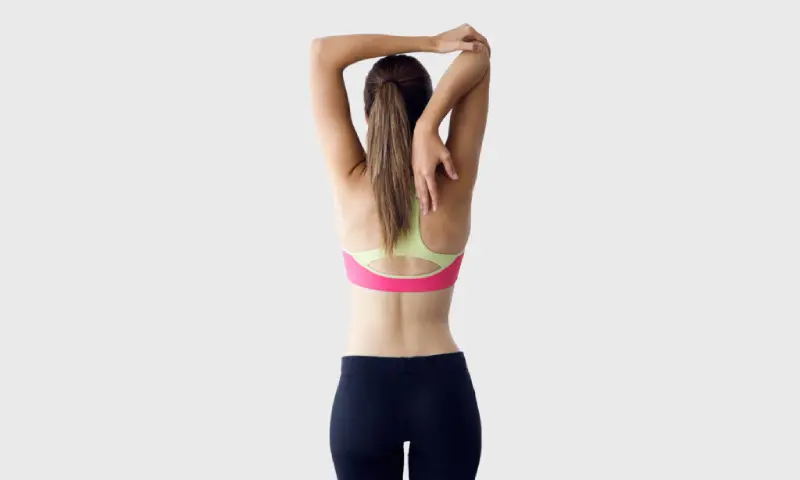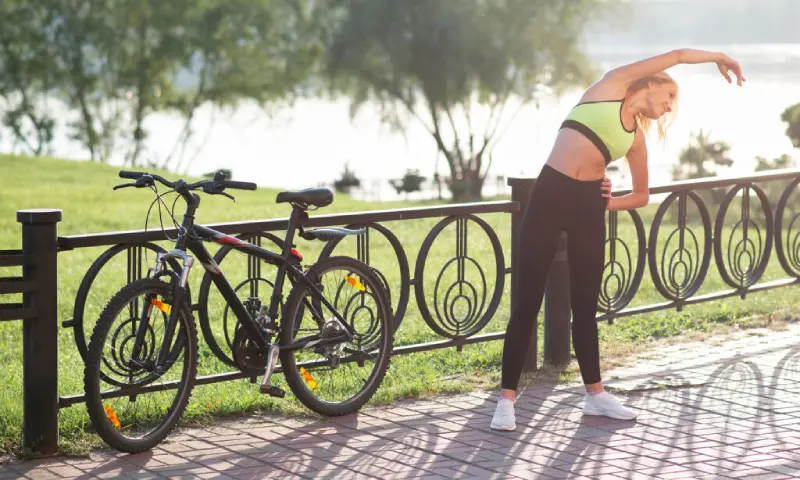Shoulder impingement syndrome is one of the most common shoulder injuries that cyclists can suffer from. It occurs when the rotator cuff tendons, which help stabilize and move the shoulder joint, get pinched or irritated by the shoulder blade or collarbone bones. This can cause pain, inflammation, stiffness, and reduced range of motion in the shoulder.
To relieve shoulder impingement for cyclists, try wall stretches exercise by leaning forward with your forearm flat. Hold for 30 seconds on each side. Also, do band rotations by pulling your hands apart while holding the band shoulder-width apart.
We’ll explore some of the best shoulder impairment exercises and stretches for cyclists and provide tips for safe and correct performance.
Shoulder Impingement Exercises for Cyclists: 7 Expert Moves

A cyclist’s routine can be supplemented with targeted exercises and stretches to alleviate shoulder impingement. We will discuss some practical best stretching exercises and try to prevent shoulder impingement in cyclists. These stretches and exercises can relieve shoulder pain.
Scapula Squeeze: Strengthening Your Upper Back Muscles
The scapula squeeze exercise is a simple yet highly effective way to strengthen your upper back. Perform this exercise as follows:
- Sit straight with your feet flat and your arms by your sides.
- Hold your shoulder blades together and pull them back and down.
- Squeeze for 5-10 seconds, then release.
- For 10-15 repetitions, repeat the exercise.
Benefits
- It helps improve posture and reduce the rounding of the shoulders.
- Strengthens the muscles around the scapula, reducing the strain on the shoulder joint during cycling.
Tips and Precautions
- Do not shrug your shoulders up to your ears during the exercise.
- Squeeze your shoulder blades together without straining your neck or upper back muscles.
Pec Opener: Stretching Out Your Chest Muscles
The pec opener stretch is an effective way for cyclists to stretch out tight chest muscles, which can contribute to shoulder impingement syndrome. Follow these steps to perform this stretch properly:
- For impingement, place a stability ball or foam roller against a wall.
- Lie down on the ball or roller with the ball/roller positioned under your shoulder blades.
- You should extend your arms out to the sides, palms facing up.
- Stretch for 30-60 seconds while breathing deeply.
Benefits
It helps stretch out tight chest muscles, possibly contributing to shoulder impingement syndrome.
- Improves shoulder mobility and range of motion for cycling.
Tips and Precautions
- Stretch without arching your lower back.
- Any time you feel discomfort or pain, stop stretching.
Shoulder Press: Building Your Shoulder Muscles
The shoulder press exercise is an excellent way for cyclists to build strength in the shoulder muscles, which can help prevent shoulder impingement syndrome. To perform this exercise properly:
- Put your feet on a stability ball and sit planted on the ground.
- Handle dumbbells forward, palms facing up.
- The dumbbells should be raised at shoulder height with elbows bent.
- Press the dumbbells up and overhead, straightening your arms.
- Return the dumbbells to shoulder height, bending your elbows.
- Repeat for 10-15 repetitions.
Benefits
- Builds shoulder strength and stability, reducing shoulder impingement symptoms.
- It improves overall mobility and shoulder range of motion, which is crucial for cycling.
Tips and precautions
- Be sure to keep your core engaged and your back straight.
- Do not lock out your elbows at the top of the movement to avoid strain on the joint.
Front and Back Shoulder Stretch: Improving Range of Motion

The front and back shoulder stretch is an excellent exercise for cyclists, loosening up the shoulder joints and improving range of motion. Here’s how to perform the stretch using a theraband or rope:
- Theraband or rope in both hands is at shoulder height, palms facing down.
- Keep your arms straight, raise the band or rope above your head, and stretch your arms behind you.
- Hold briefly, then slowly lower the band or rope back to shoulder height.
- Repeat 10-15 times or as many as you can comfortably do without causing pain.
Benefits
Stretching the front and back shoulders can help alleviate shoulder impingement syndrome symptoms in cyclists by:
- Improving range of motion.
- Stretching the shoulder muscles and joints.
- Reducing stiffness and tightness.
- Increasing blood flow to the affected area.
Tips and Precautions
To perform shoulder stretches safely and effectively, keep these tips in mind:
- Warm up your shoulders before stretching with gentle shoulder rolls and circles.
- You should stop the stretch if you are in pain or discomfort.
- Avoid overstretching or bouncing, as this can lead to injury.
- Breathe deeply and slowly throughout the stretch.
External and Internal Rotation: Strengthening Shoulder Rotator Cuff Muscles
External and internal rotation shoulder impingement exercises are designed to improve the strength and stability of the cyclist’s shoulder’s rotator cuff muscles. Here’s how to perform these exercises using a theraband or resistance band:
- Put the band on a stable object at waist height.
- Stand facing the band and hold it with one hand, with your elbow bent at a 90-degree angle and your upper arm at your side.
- Slowly rotate your arm outwards against the band’s resistance, then return to the starting position.
- Repeat 10-15 times on each side, as many times as possible without feeling pain.
Benefits
External and internal rotation exercises relieve cyclist’s shoulder impingement syndrome symptoms by:
- Strengthening the rotator cuff muscles.
- Improving shoulder stability and alignment.
- Reducing the risk of further injury.
- Enhancing cycling performance by increasing power and speed
Tips and Precautions
To perform external and internal rotation exercises safely and correctly, follow these tips:
- Use a light resistance band to start with, gradually increasing as you build strength.
- Keep your elbow against your side and your core engaged throughout the exercise.
- Don’t rotate your arm past a comfortable range of motion.
- If you feel pain or discomfort during the exercise, stop.
Conclusion
Shoulder Impingement Syndrome can be a common and frustrating ailment for cyclists, but with the proper exercises and stretches, you can alleviate the pain and improve your shoulder mobility.
The external and internal rotation exercises are all great options to strengthen your upper back, increase mobility, and prevent future injuries. Make sure to perform these exercises and stretches regularly and consistently to see the best results in your cycling performance. Medical professionals or certified personal trainers can provide further guidance.
FAQs
Is Yoga Good For Shoulder Impingement?
Yoga can benefit shoulder impingement when done mindfully with a qualified instructor. Specific poses improve shoulder mobility, strengthen muscles, and encourage better posture to ease symptoms. Avoid poses worsening pain, modify movements causing strain, and focus on gentle exercises for shoulder stability and motion range.
Shoulder Impingement Can Be Fixed By Stretching?
While resting your shoulder is ideal, you can also perform gentle exercises to stretch the muscles in your arm, shoulder, and chest while strengthening your rotator cuff. Performing these exercises regularly can prevent cyclists’ shoulder pain and impingement from exacerbating.


